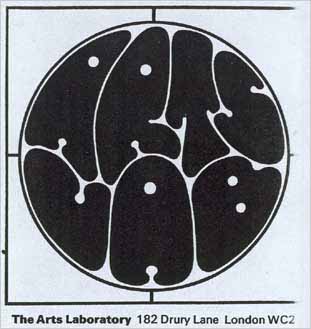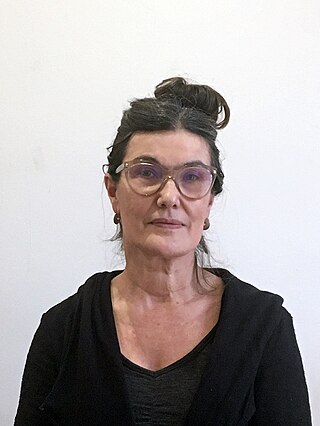Related Research Articles
Video art is an art form which relies on using video technology as a visual and audio medium. Video art emerged during the late 1960s as new consumer video technology such as video tape recorders became available outside corporate broadcasting. Video art can take many forms: recordings that are broadcast; installations viewed in galleries or museums; works streamed online, distributed as video tapes, or DVDs; and performances which may incorporate one or more television sets, video monitors, and projections, displaying live or recorded images and sounds.
Community theatre refers to any theatrical performance made in relation to particular communities—its usage includes theatre made by, with, and for a community. It may refer to a production that is made entirely by a community with no outside help, or a collaboration between community members and professional theatre artists, or a performance made entirely by professionals that is addressed to a particular community. Community theatres range in size from small groups led by single individuals that perform in borrowed spaces to large permanent companies with well-equipped facilities of their own. Many community theatres are successful, non-profit businesses with a large active membership and, often, a full-time staff. Community theatre is often devised and may draw on popular theatrical forms, such as carnival, circus, and parades, as well as performance modes from commercial theatre. This type of theatre is ever-changing and evolving due to the influences of the community; the artistic process can often be heavily affected by the community's socioeconomic circumstances.
A regional theater or resident theater in the United States is a professional or semi-professional theater company that produces its own seasons. The term regional theater most often refers to a professional theater outside New York City. A regional theater may or may not be for profit or unionized.

Experimental theatre, inspired largely by Wagner's concept of Gesamtkunstwerk, began in Western theatre in the late 19th century with Alfred Jarry and his Ubu plays as a rejection of both the age in particular and, in general, the dominant ways of writing and producing plays. The term has shifted over time as the mainstream theatre world has adopted many forms that were once considered radical.

The Market Theatre, based in the downtown bohemian suburb of Newtown in Johannesburg, South Africa, was opened in 1976, operating as an independent, anti-racist theatre during the country's apartheid regime. It was named after a fruit and vegetable market that was previously located there. It was also known as the Old Indian Market or the Newtown Market, which closed after 60 years. The Market Theatre was renamed John Kani Theatre in 2014 after the renowned South African stage actor John Kani.
The London Film-makers' Co-op, or LFMC, was a British film-making workshop founded in 1966. It ceased to exist in 1999 when it merged with London Video Arts to form LUX.

Cubo-Futurism or Kubo-Futurizm was an art movement, developed within Russian Futurism, that arose in early 20th century Russian Empire, defined by its amalgamation of the artistic elements found in Italian Futurism and French Analytical Cubism. Cubo-Futurism was the main school of painting and sculpture practiced by the Russian Futurists. In 1913, the term "Cubo-Futurism" first came to describe works from members of the poetry group "Hylaeans", as they moved away from poetic Symbolism towards Futurism and zaum, the experimental "visual and sound poetry of Kruchenykh and Khlebninkov". Later in the same year the concept and style of "Cubo-Futurism" became synonymous with the works of artists within Ukrainian and Russian post-revolutionary avant-garde circles as they interrogated non-representational art through the fragmentation and displacement of traditional forms, lines, viewpoints, colours, and textures within their pieces. The impact of Cubo-Futurism was then felt within performance art societies, with Cubo-Futurist painters and poets collaborating on theatre, cinema, and ballet pieces that aimed to break theatre conventions through the use of nonsensical zaum poetry, emphasis on improvisation, and the encouragement of audience participation.
Lee Wen was a Singapore-based performance artist who shaped the development of performance art in Asia. He worked on the notion of identity, ethnicity, freedom, and the individual's relationship to communities and the environment. Lee's most iconic work is his performance series titled The Journey of aYellow Man, which started as a critique of racial and ethnic identities in 1992 and has evolved into a meditation on freedom, humility, and religious practices over more than a decade. Painting his own body with bright yellow poster paint, he expresses an exaggerated symbol of his ethnic identity as a citizen of Singapore. He was also active in artist-run initiatives, especially as part of The Artists Village (TAV) in Singapore, the performance artist collective Black Market International, as well as the festivals Future of Imagination and Rooted in the Ephemeral Speak (R.I.T.E.S.). On 3 March 2019, he died due to a lung infection, at the age of 61.
Double Edge Theatre is an artist-run organization founded in 1982 by Stacy Klein. Focusing on vigorous physical training and the principle of an artist's autonomy, the company has sought to create work in an ensemble setting intimately woven with the community.
Australian feminist art timeline lists exhibitions, artists, artworks and milestones that have contributed to discussion and development of feminist art in Australia. The timeline focuses on the impact of feminism on Australian contemporary art. It was initiated by Daine Singer for The View From Here: 19 Perspectives on Feminism, an exhibition and publishing project held at West Space as part of the 2010 Next Wave Festival.

The Arts Lab was an alternative arts centre, founded in 1967 by Jim Haynes at 182 Drury Lane, London. Although only active for two years, it was influential in inspiring many similar centres in the UK, continental Europe and Australia, including the expanded Institute of Contemporary Arts (ICA) in London, the Milky Way/Melkweg in Amsterdam, the Entrepôt in Paris and the Yellow House Artist Collective founded by Martin Sharp in Sydney.

JoWonder, born Joanna Woodward, has a multidisciplined artistic practice, she is a British painter, avant-garde stopmotion animator, performance artist and writer. She is noted for being from a generation of British avant-garde animators such as Brothers Quay and David Anderson. They made/make work which brings concepts from postmodern literature, the surrealist movement, and contemporary art to cinema. Her films, which use collage, textured painting, and text, provide counterpoint between the metaphysical and the playful. Lilliputian characters are often introduced to an apocalyptic realm ruled by giants. Her work combines religious, political, fairy-tale, and scientific themes using satire and symbolism.

FoolishPeople is a British theatre and production collective specialising in original site-specific and immersive theatre, as well as independent film and books. The collective was founded in 1989 by John Harrigan, who developed the theatre practice Theatre of Manifestation. Combining ritual, mythology, shamanism, drama therapy, strategic forecasting and open source collaboration in the creation of FoolishPeople's work. Each project takes form by merging text, performance, sound, art, light and the building itself to create dreamlike worlds that living characters inhabit. FoolishPeople were one of the early pioneers of immersive theatre in the UK and have utilised transmedia within their work since their inception in 1989.
Scary Little Girls is an English production hub based in London and Cornwall and a charity registered in England and Wales under charity number 1136270. Most of their work revolves around literary and matrifocal themes, as well as a number of comedy and cabaret works with predominantly female casts. Rather than working primarily a set genre or using a regular group of practitioners, the company looks to seek out artists of all ages, backgrounds and interests from multiple artistic fields. A key tenet of SLG projects is that must headline, promote or employ more women than men.

The Lancaster Institute for the Contemporary Arts is an academic institution, art school, and arm of the University of Lancaster, that delivers research and teaching in fields of contemporary art and design; including in the subject areas of Fine Art, Theatre, Design, and Film studies. The institute also houses two research centres: Insight and Imagination. LICA has a close working relationship with the public arts organisation: Lancaster Arts.
Lancaster Arts at Lancaster University (LA) is Lancaster University's public arts organisation. The organisation presents performances, for the public, staff and students, through its campus venues the Nuffield Theatre, Lancaster Concerts Series and the Peter Scott Gallery.
The Centre for Experimental Art and Communication (CEAC) was a Canadian artist-run centre that developed out of the Kensington Arts Association (KAA) [1973-1978] in 1976 as a multimedia space that provided an important venue for experimental and avant-garde art in Toronto, Ontario and beyond. CEAC was the first ever multi-media centre owned and operated by an artist-run centre in Toronto and the largest non-institutional art space during its time. The centre engaged with artists, musicians, and activists from across North America through organized exhibitions, in addition to hosting video production facilities, workshops, screening, and performance series'. CEAC encouraged artist-to-artist communication and provided a platform for Canadian artists to expand their knowledge through international tours. The centre was also home to the radical art magazine Art Communication Edition, later renamed STRIKE. Despite its success as an artist-run centre from 1976 through to 1978, CEAC was disbanded in the summer of 1978 following scandal and the withdrawal of government funding from the Ontario Arts Council

Emmanuelle Waeckerlé is an experimental musician, multidisciplinary artist and composer based in London. Her text scores, publications, and performances explore the materiality and musicality of language while proposing playful encounters with our "interior or exterior landscape and each other."
References
- 1 2 "Dead Good Guides page for John Fox". deadgoodguides.com. Retrieved 26 May 2018.
- 1 2 "Dead Good Guides page for Sue Gill". deadgoodguides.com. Retrieved 26 May 2018.
- 1 2 3 "Welfare State International - About WSI". welfare-state.org. Retrieved 26 May 2018.
- 1 2 Nuttall, Jeff (1979). Performance Art Memoirs. Vol. 1. John Calder. p. 72. ISBN 0714537888.
- 1 2 Whiteley, Gillian. "'New Age' radicalism and the social imagination: Welfare State International in the Seventies" (PDF). dspace.lboro.ac.uk. Retrieved 30 May 2018.
- 1 2 "Welfare State International - John Fox". welfare-state.org. Retrieved 26 May 2018.
- 1 2 "Guardian article Experimental theatre to spill into the mainstream". theguardian.com. 1 April 2009. Retrieved 26 May 2018.
- ↑ "Dead Good Guides | An artist-led company". deadgoodguides.co.uk. Retrieved 4 December 2023.
- ↑ "Events & Workshops | Dead Good Guides". deadgoodguides.co.uk. Retrieved 2023-03-16.
- ↑ "A Hand on the Tiller | Total Theatre Magazine Print Archive". totaltheatre.org.uk. Retrieved 2023-03-16.